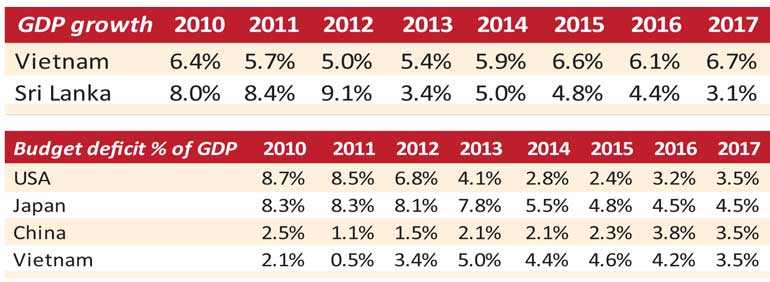Friday Dec 26, 2025
Friday Dec 26, 2025
Tuesday, 5 March 2019 00:01 - - {{hitsCtrl.values.hits}}
In this column we have kept on saying that reducing the budget deficit should not be the priority of the Government. We’ll touch on the topic one more time, as the Government presents the budget today. While the deficit was targeted to be reduced to 4.8% of GDP in 2018 (from 5.5% in 2017) it is unlikely to have reduced much. We are likely to see the Government proposing yet again to reduce it to under 5% in 2019.
We would focus on examples both from Government and private entities to justify our rationale that at this point in time, reducing the budget deficit should not be priority.

Many countries maintain budget deficits
If one analyses a number of developed and rapidly developing countries, quite a few of those maintain substantial Government budget deficits. In the developed world, major economic powerhouses such as USA, UK and Japan consistently maintain a deficit.
Even in the fast developing world, major players such as China and Vietnam also run consistent Government budget deficits. Therefore the question arises why does Sri Lanka consider reducing the budget deficit as the single most important objective?
Growth more important than budget deficit
One could get further clarity on the matter when the economic growth of countries is considered. Fast developing countries such as China and Vietnam have achieved steady high growth rates over a relatively long period, which is the prime reason for investors to be attracted to such countries. Clearly the investors do not mind budget deficits as long as there is sustainable growth.
Sri Lanka on the other hand has taken a different direction to reduce budget deficit through increasing taxes and curtailing expenditure, which has resulted in a significant reduction in growth. Hence, one shouldn’t be surprised why investors are not rushing into Sri Lanka.
Real investors look for growth. It’s the passive investors who look at ratios and yields (financial discipline, etc.). The current strategy has resulted in Sri Lanka attracting the less desirable investors (lenders to be exact) who seek higher yields rather than capital gains, which is detrimental to Sri Lanka’s growth story.
Since independence over 70 years ago, only once did Sri Lanka achieve a 5 year period of annual average growth of 7%. In contrast, fast growing economies such as Singapore and Taiwan recorded annual average growth in excess of 7% for three decades.

Classic examples in private sector
It would be interesting to draw parallels from the private sector. Let’s look at how some of today’s great companies performed at the start of their lives.
The global giant Amazon was making losses in the initial years. In fact, the losses were quite substantial. For instance, in year 2000 when the revenue was $ 2,762 m, the company made a staggering loss of $ 1,411 m. However the company was focusing on sustainable growth and it was confident of turning around and becoming profitable as long as it grew its revenue and captured market. The revenue growth was phenomenal during the initial years as from $ 610 m in 1998 they increased over five times to $ 3,933 m by 2002 in a mere four years. However they were still making losses by 2002. They became marginally profitable in 2003 and didn’t look back ever since. In 2018 its revenue was $ 232,887 m while the profit was $ 10,073 m.
Fedex, the global delivery giant, also incurred heavy losses in its initial years from 1973-1975, although its revenue grew steadily. It turned around to a marginal profit in 1976 and improved profitability steadily thereafter. In 2018 it recorded a revenue of $ 65,450 m and a profit of $ 4,572 m.
Clearly these were exceptional success stories and by no means should one generalise these examples. However the underlying logic is, sustainable growth is more important than short term financial discipline. That’s what attracts investors and boost investor confidence. This is true for companies, and true for countries as well.
A better fiscal strategy
Therefore Sri Lanka should seriously consider expanding the budget deficit from 5.5% towards 7% of GDP. This would be close to an additional Rs. 200 b p.a. of either higher expenditure on strategic ventures by the Government or relaxing taxes for strategic industries. The objective is to set the country on a sustainable growth path in the near future. Once the country reaches a sustainable high growth path of 7-8% (from the current level of 3-4%), focus could shift to reducing budget deficit from 7% gradually. It would be possible once the economy is healthy and the investors are confident about the economy.
Slightly higher risk strategy
However this is a slightly higher risk strategy as one could understand. Political stability and policy consistency are pre-requisites for this to succeed. As Sri Lanka is on the verge of appointing a new President and a new Parliament, one could expect stability for five years, which is sufficient to launch this strategy. On the other hand, the current strategy of pursuing lower fiscal deficits at the expense of low growth is a recipe for frustration and possibly a slow painful end result.
It is very doubtful that we would hear anything like the proposed strategy at today’s budget proposals from the Government. As mentioned earlier, having spent around 75% of its lifetime, the President and the Government is a little too late to launch such a decisive strategy. However it should be a serious option for all those who are waiting for the next five-year term.
(The writers can be contacted via [email protected].)